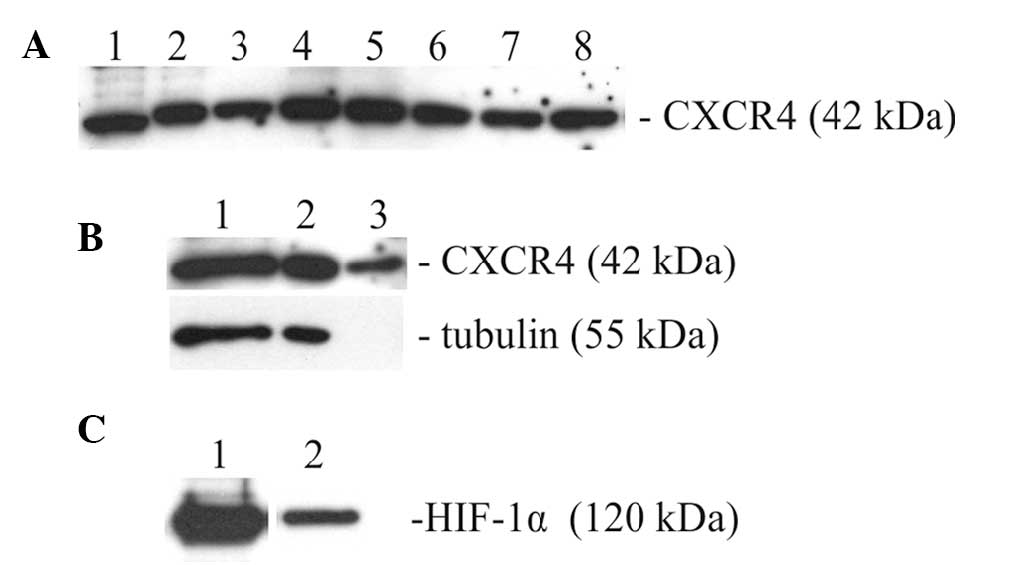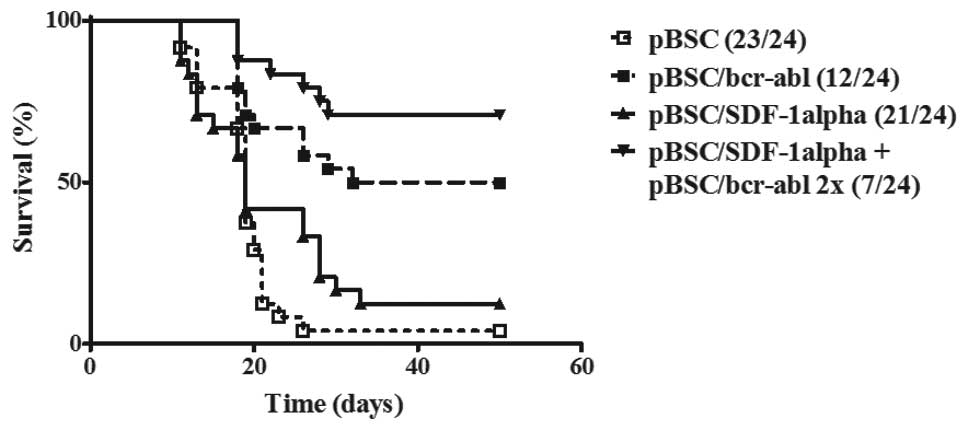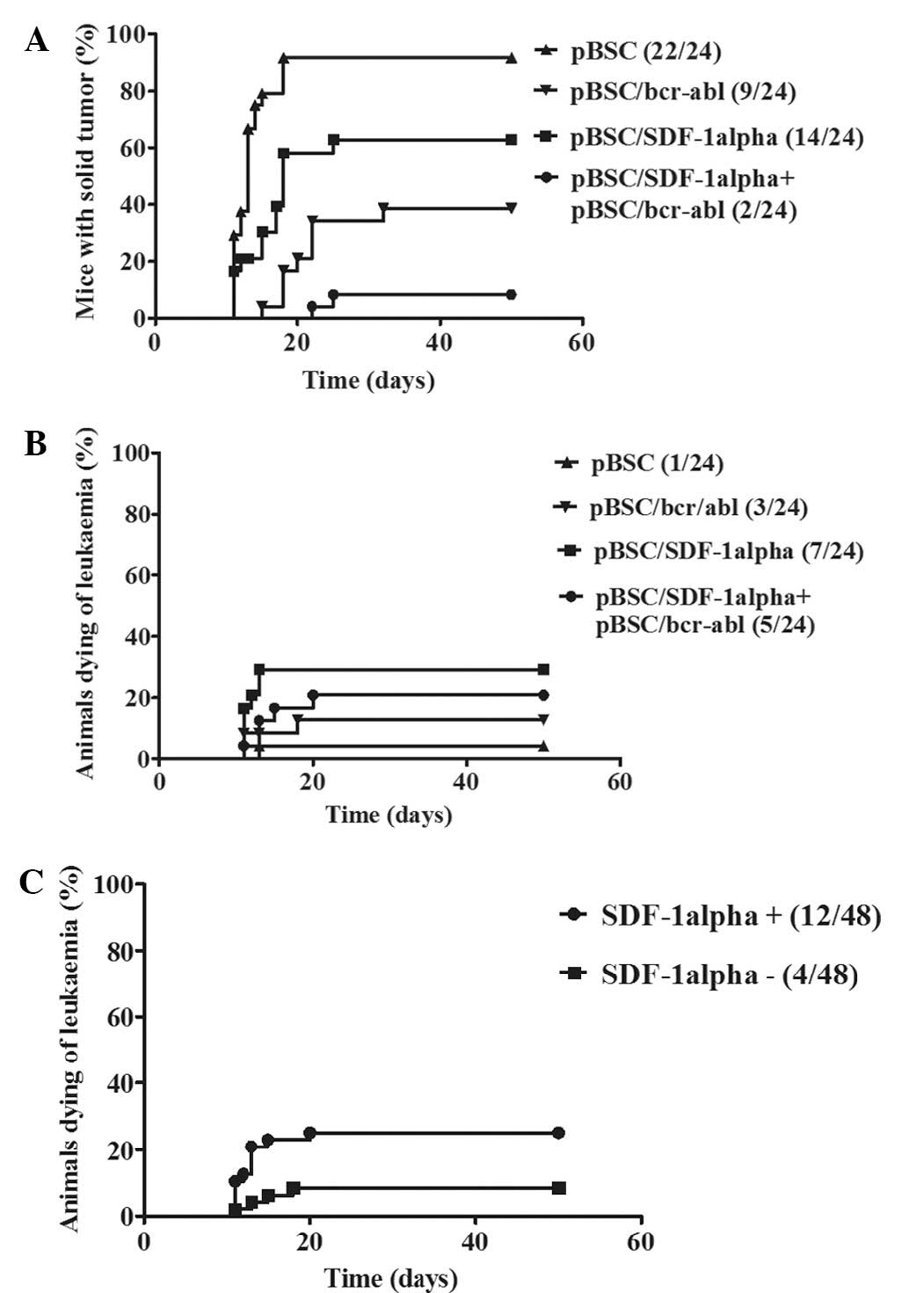|
1
|
Raman D, Baugher PJ, Thu YM and Richmond
A: Role of chemokines in tumor growth. Cancer Lett. 256:137–165.
2007. View Article : Google Scholar : PubMed/NCBI
|
|
2
|
Kryczek I, Wei S, Keller E, Liu R and Zou
W: Stroma-derived factor (SDF-1/CXCL12) and human tumor
pathogenesis. Am J Physiol Cell Physiol. 292:C987–C995. 2007.
View Article : Google Scholar : PubMed/NCBI
|
|
3
|
Nagasawa T, Kikutani H and Kishimoto T:
Molecular cloning and structure of a pre-B-cell growth-stimulating
factor. Proc Natl Acad Sci USA. 91:2305–2309. 1994. View Article : Google Scholar : PubMed/NCBI
|
|
4
|
Burger JA and Kipps TJ: CXCR4: a key
receptor in the crosstalk between tumor cells and their
microenvironment. Blood. 107:1761–1767. 2006. View Article : Google Scholar : PubMed/NCBI
|
|
5
|
Karin N: The multiple faces of CXCL12
(SDF-1alpha) in the regulation of immunity during health and
disease. J Leukoc Biol. 88:463–473. 2010. View Article : Google Scholar : PubMed/NCBI
|
|
6
|
Duda DG, Kozin SV, Kirkpatrick ND, et al:
CXCL12 (SDF1alpha)-CXCR4/CXCR7 pathway inhibition: an Emerging
sensitizer for anticancer therapies? Clin Cancer Res. 17:2074–2080.
2011. View Article : Google Scholar : PubMed/NCBI
|
|
7
|
Burns JM, Summers BC, Wang Y, et al: A
novel chemokine receptor for SDF-1 and I-TAC involved in cell
survival, cell adhesion, and tumor development. J Exp Med.
203:2201–2213. 2006. View Article : Google Scholar : PubMed/NCBI
|
|
8
|
Hattermann K and Mentlein R: An infernal
trio: the chemokine CXCL12 and its receptors CXCR4 and CXCR7 in
tumor biology. Ann Anat. 195:103–110. 2013. View Article : Google Scholar : PubMed/NCBI
|
|
9
|
Kucia M, Reca R, Miekus K, et al:
Trafficking of normal stem cells and metastasis of cancer stem
cells involve similar mechanisms: pivotal role of the SDF-1-CXCR4
axis. Stem Cells. 23:879–894. 2005. View Article : Google Scholar : PubMed/NCBI
|
|
10
|
Brzoska E, Kowalewska M,
Markowska-Zagrajek A, et al: Sdf-1 (CXCL12) improves skeletal
muscle regeneration via the mobilisation of CXCR4 and CD34
expressing cells. Biol Cell. 104:722–737. 2012. View Article : Google Scholar : PubMed/NCBI
|
|
11
|
Orimo A, Gupta PB, Sgroi DC, et al:
Stromal fibroblasts present in invasive human breast carcinomas
promote tumor growth and angiogenesis through elevated SDF-1/CXCL12
secretion. Cell. 121:335–348. 2005. View Article : Google Scholar
|
|
12
|
Wang J, Wang J, Dai J, et al: A glycolytic
mechanism regulating an angiogenic switch in prostate cancer.
Cancer Research. 67:149–159. 2007. View Article : Google Scholar : PubMed/NCBI
|
|
13
|
Cojoc M, Peitzsch C, Trautmann F, et al:
Emerging targets in cancer management: role of the CXCL12/CXCR4
axis. Onco Targets Ther. 6:1347–1361. 2013.PubMed/NCBI
|
|
14
|
Schimanski CC, Galle PR and Moehler M:
Chemokine receptor CXCR4-prognostic factor for gastrointestinal
tumors. World J Gastroenterol. 14:4721–4724. 2008. View Article : Google Scholar : PubMed/NCBI
|
|
15
|
Felix AS, Weissfeld J, Edwards R and
Linkov F: Future directions in the field of endometrial cancer
research: the need to investigate the tumor microenvironment. Eur J
Gynaecol Oncol. 31:139–144. 2010.
|
|
16
|
Burger JA and Peled A: CXCR4 antagonists:
targeting the microenvironment in leukemia and other cancers.
Leukemia. 23:43–52. 2009. View Article : Google Scholar : PubMed/NCBI
|
|
17
|
Lee Ch, Kakinuma T, Wang J, et al:
Sensitization of B16 tumor cells with a CXCR4 antagonist increases
the efficacy of immunotherapy for established lung metastases. Mol
Cancer Ther. 5:2592–2599. 2006. View Article : Google Scholar : PubMed/NCBI
|
|
18
|
McLaughlin J, Chianese E and Witte ON: In
vitro transformation of immature hematopoietic cells by the P210
BCR/ABL oncogene product of the Philadelphia chromosome. Proc Natl
Acad Sci USA. 84:6558–6562. 1987. View Article : Google Scholar
|
|
19
|
Lucansky V, Sobotkova E, Tachezy R,
Duskova M and Vonka V: DNA vaccination against bcr-abl-positive
cells in mice. Int J Oncol. 35:941–951. 2009.PubMed/NCBI
|
|
20
|
Jelínek F1, Sobotková E and Vonka V:
Characteristics of two mouse bcr-abl-transformed cell lines. II
Pathological lesions induced in mice. Folia Biol (Praha).
51:93–102. 2005.PubMed/NCBI
|
|
21
|
Sobotkova E1, Ludvíková V, Petrácková M,
et al: Characteristic of two mouse bcr-abl-transformed cell lines:
I. General properties of the cells. Folia Biol (Praha). 51:12–18.
2005.PubMed/NCBI
|
|
22
|
Jinoch P, Zak R, Janousková O, et al:
Immunization with live HPV-16-transformed mouse cells expressing
the herpes simplex thymidine kinase and either GM-CSF or IL-2. Int
J Oncol. 23:775–783. 2003.PubMed/NCBI
|
|
23
|
Ludvíková V1, Hamsíková E, Sobotková E, et
al: Use of polyclonal rabbit antibodies for detection of the
bcr-abl fusion zone in cells transfected with experimental bcr-abl
DNA vaccines. Int J Oncol. 27:265–274. 2005.PubMed/NCBI
|
|
24
|
Smahel M, Síma P, Ludvíková V and Vonka V:
Modified HPV16 E7 genes as DNA vaccine against E7-containing
oncogenic Cells. Virology. 281:231–238. 2001. View Article : Google Scholar : PubMed/NCBI
|
|
25
|
Hrbacek J, Urban M, Hamsikova E, et al:
Serum antibodies against genitourinary infectious agents in
prostate cancer and benign prostate hyperplasia patients: a
case-control study. BMC Cancer. 11:532011. View Article : Google Scholar
|
|
26
|
Poláková I1, Pokorná D, Dusková M and
Smahel M: DNA vaccine against human papillomavirus type 16:
modifications of the E6 oncogene. Vaccine. 28:1506–1513.
2010.PubMed/NCBI
|
|
27
|
Cronin P, Wang J and Redmond HP: Hypoxia
increases the metastatic ability of breast cancer cells via
upregulation of CXCR4. BMC Cancer. 10:2252010. View Article : Google Scholar : PubMed/NCBI
|
|
28
|
Zhang H, Li H, Xi HS and Li S: HIF1α is
required for survival maintenance of chronic myeloid leukemia stem
cells. Blood. 119:2595–2607. 2012.
|
|
29
|
Kittang AO, Hatfield K, Sand K, Reikvam H
and Bruserud Ø: The chemokine network in acute myelogenous
leukemia: molecular mechanisms involved in leukemogenesis and
therapeutic implications. Curr Top Microbiol Immunol. 341:149–172.
2010.
|
|
30
|
Kato I, Niwa A, Heike T, et al:
Identification of hepatic niche harboring human acute lymphoblastic
leukemic cells via the SDF-1/CXCR4 axis. PLoS One. 6:e270422011.
View Article : Google Scholar : PubMed/NCBI
|
|
31
|
Kawaguchi A, Orba Y, Kimura T, et al:
Inhibition of the SDF-1alpha-CXCR4 axis by the CXCR4 antagonist
AMD3100 suppresses the migration of cultured cells from ATL
patients and murine lymphoblastoid cells from HTLV-I Tax transgenic
mice. Blood. 114:2961–2968. 2009. View Article : Google Scholar : PubMed/NCBI
|
|
32
|
Sison EA and Brown P: The bone marrow
microenvironment and leukemia: biology and therapeutic targeting.
Expert Rev Hematol. 4:271–283. 2011. View Article : Google Scholar : PubMed/NCBI
|
|
33
|
Salgia R, Quackenbush E, Lin J, et al: The
BCR/ABL oncogene alters the chemotactic response to stromal-derived
factor-1alpha. Blood. 94:4233–4246. 1999.PubMed/NCBI
|
|
34
|
Dürig J, Rosenthal C, Elmaagacli A, et al:
Biological effects of stroma-derived factor-1 alpha on normal and
CML CD34+ haemopoietic cells. Leukemia. 14:1652–1660.
2000.PubMed/NCBI
|
|
35
|
Ptasznik A, Urbanowska E, Chinta S, et al:
Crosstalk between BCR/ABL oncoprotein and CXCR4 signaling through a
Src family kinase in human leukemia cells. J Exp Med. 196:667–678.
2002. View Article : Google Scholar : PubMed/NCBI
|
|
36
|
Geay JF, Buet D, Zhang Y, et al:
p210BCR-ABL inhibits SDF-1 chemotactic response via alteration of
CXCR4 signaling and down-regulation of CXCR4 expression. Cancer
Res. 65:2676–2683. 2005. View Article : Google Scholar : PubMed/NCBI
|
|
37
|
Chen YY, Malik M, Tomkowicz BE, Collman RG
and Ptasznik A: BCR-ABL1 alters SDF-1alpha-mediated adhesive
responses through the beta2 integrin LFA-1 in leukemia cells.
Blood. 111:5182–5186. 2008. View Article : Google Scholar : PubMed/NCBI
|
|
38
|
Yu W, Sun X, Tang H, Tao Y and Dai Z:
Inhibition of class II phosphoinositide 3-kinase gamma expression
by p185(Bcr-Abl) contributes to impaired chemotaxis and aberrant
homing of leukemic cells. Leuk Lymphoma. 51:1098–1107. 2010.
View Article : Google Scholar : PubMed/NCBI
|
|
39
|
Chang YC, Tien SC, Tien HF, et al:
p210Bcr-Abl desensitizes Cdc42 GTPase signaling for
SDF-1alpha-directed migration in chronic myeloid leukemia cells.
Oncogene. 28:4105–4115. 2009. View Article : Google Scholar : PubMed/NCBI
|
|
40
|
Tabe Y, Jin L, Iwabuchi K, et al: Role of
stromal microenvironment in nonpharmacological resistance of CML to
imatinib through Lyn/CXCR4 interactions in lipid rafts. Leukemia.
26:883–892. 2012. View Article : Google Scholar : PubMed/NCBI
|
|
41
|
Fruehauf S, Srbic K, Seggewiss R, Topaly J
and Ho AD: Functional characterization of podia formation in normal
and malignant hematopoietic cells. J Leukoc Biol. 71:425–432.
2002.PubMed/NCBI
|
|
42
|
Cashman J, Clark-Lewis I, Eaves A and
Eaves C: Stromal-derived factor 1 inhibits the cycling of very
primitive human hematopoietic cells in vitro and in NOD/SCID mice.
Blood. 99:792–799. 2002. View Article : Google Scholar : PubMed/NCBI
|
|
43
|
Salanga CL, O’Hayre M and Handel T:
Modulation of chemokine receptor activity through dimerization and
crosstalk. Cell Mol Life Sci. 66:1370–1386. 2009. View Article : Google Scholar : PubMed/NCBI
|
|
44
|
Ratajczak MZ, Serwin K and Schneider G:
Innate immunity derived factors as external modulators of the
CXCL12-CXCR4 axis and their role in stem cell homing and
mobilization. Theranostics. 3:3–10. 2013. View Article : Google Scholar : PubMed/NCBI
|













